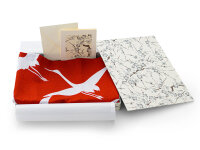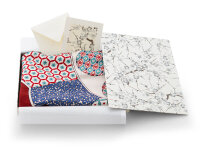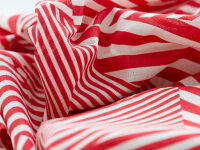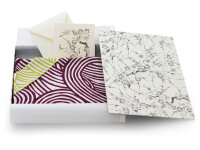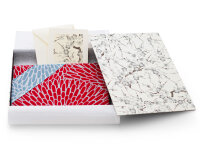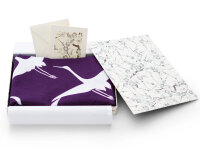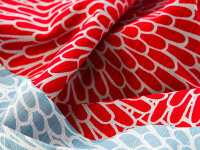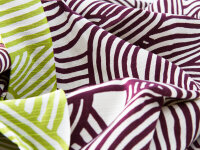
Furoshiki Japanese Cloth
Furoshiki – What Is It?
Furoshiki represents minimalism and functionality in Japan. These square cloths, known as Furoshiki, have been used in Japan for hundreds of years to wrap and carry various items. The possibilities are nearly limitless, allowing your imagination to run wild. Whether it's a simple grocery bag or an intricately knotted handbag, Furoshiki is a delightful challenge to your creativity. You can find inspiration and Furoshiki instructions here in our Japan Magazine.
A Furoshiki can be used in a highly flexible manner, serving as:
- Practical Shopping Bag: Fits in a pocket and fulfills its purpose when folded
- Stylish Handbag: Furoshiki comes in various colors, and two-colored ones can be worn in two designs
- Packaging for Bento Boxes and Oryoki Bowls: It is particularly popular in Japan to wrap Bento boxes in Furoshiki. Packaging Oryoki bowls in Furoshiki is a Buddhist tradition
- Placemat: The packaging for Oryoki bowls is also used as a beautiful placemat
- Eco-Friendly Gift Wrapping: The Japanese value packaging greatly. The versatile additional use significantly enhances the gift
- Fashionable Scarf: Last but not least, it's simply a beautiful fashion accessory, especially in spring
Eco-Friendly Gift Wrapping with Furoshiki
Furoshiki embodies warmth and gratitude. When Japanese people hand over a gift wrapped in a beautiful Furoshiki, they are said to have "extended their heart." In recent years, the trend has grown to reduce the use of paper and bags, opting instead to wrap gifts in Furoshiki, making it a gift in itself.
At Oryoki, we also offer Furoshiki as gift packaging. Both tea gifts and other items can be eco-friendly presents in a whole new way!
Furoshiki Bags Without Needles and Thread
Japanese packaging artists and folding specialists are famous for Japanese origami folding techniques. However, the folding technique for Furoshiki also dates back to the 7th century when Furoshiki was already used for transporting goods and packaging.
In Japan, in recent decades, Western packaging became increasingly popular, pushing the tradition into the background. However, in recent years, the art of Furoshiki wrapping has experienced a revival and is becoming more popular both in Japan and in the West. Skilled folding techniques can quickly turn square Furoshiki into various types of bags. You can find Furoshiki instructions on our blog and in numerous videos on YouTube.
Fabric for Furoshiki - Tradition Uses Silk and Cotton
Most Furoshiki are made from cotton, featuring an incredible variety of patterns. Classic motifs and themes remain popular, but typically Japanese, modernity also has its place. That's Japan for you: it masterfully blends tradition and modernity.
In Japan, there are even Furoshiki artworks where every thread is hand-strung to the next, creating a highly traditional design used as wall hangings. The technique is extremely intricate, making these artworks quite expensive. Furoshiki with family initials or special designs for occasions such as weddings are also very popular in Japan.
Furoshiki at Oryoki
We have chosen a mix of traditional and modern motifs for our selection. Pay attention to the different sizes when making your choice. A Furoshiki cloth is usually available in several sizes, and the size should match the intended use. The Silk Furoshiki Crane and Blue Wave are particularly suitable as scarves and are shipped in an elegant wooden box. The Furoshiki Saikosome are wonderful for gift wrapping.
Especially for gift occasions, Furoshiki is sent in a gift set in a beautiful box made of authentic, hand-printed Chiyogami paper.

